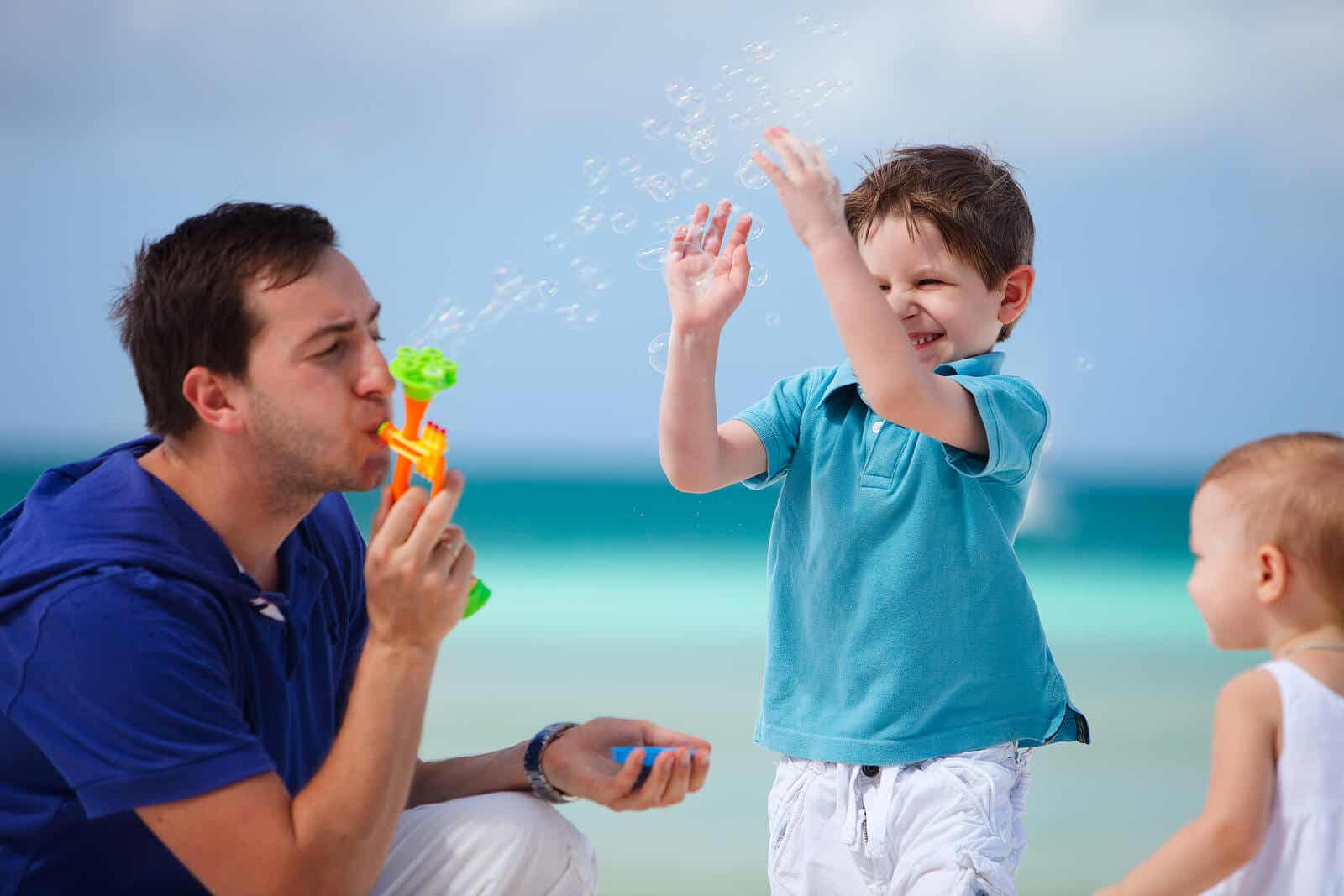The Independent Child and Healthy Parental Attachment

Attachment is the womb of maturation, and one of the fruits of a deep and nurturing relationship is the bias created in a child to become their own person. What does this bias look like and how can we support it? If you’ve ever heard the words, “Let me do it myself,” then you’ve witnessed a basic example of this energy in a child. If your child has independence, it’s because they have a healthy parental attachment, and that’s thanks to you.
When a child’s attachment needs are met, their energy shifts toward exploration, interest, and curiosity, forming their own ideas, and even goal setting. Your child will be developing properly!
The need for connection for healthy attachment parenting
For a preschooler, this can be expressed through phrases such as, “Let me do it myself!” Or, “I can do it!” For example, a three-year-old can put on their own pants or tie their own seat belt in the car. They may struggle to do this, but just the fact that they’re trying to do it on their own is already very positive in their development. When this happens, it’s because their parents are meeting their relational needs.

When a toddler tells you they want to do something themselves, they’re trying to push the boundaries of who they are. The life force to become a unique and independent person exists in each of us, but the key to unlocking it lies in these fulfilling relationships.
Strong parental attachment with children
Strong attachment unlocks the bias to become their own person and they begin to move through their world with their own preferences, meanings, ideas, and initiatives in tow. One of the number one values parents have for their children is independence and responsibility.
This isn’t something we can teach a child, but we can facilitate its development. The path to “I can do it” and independence lies in meeting their dependency needs first and making them realize that they’re capable of achieving things on their own.
When children know that we’ll be there for them, they can jump into new environments of their own making. They’re free to discover new places knowing that there’s always a home to return to. We all need to feel anchored, and relationships hold us in place.
If we want our children to jump in and discover what they can really do for themselves, then we don’t have to push, we have to meet their needs. When they’re full of all we have to offer, they’ll look at us with a lot of defiance and dignity, and say, “Don’t help me, I’ll do it myself!” We shouldn’t be offended, but see it as the fruit of our care.
“Never help a child with a task at which he feels he can succeed.”
-Maria Montessori-
The goal of parenting is to turn children into independent and happy beings
The goal of parenting is to help children become viable and independent human beings. While today’s “I can do it” may seem small and insignificant, they’re the building blocks for tomorrow’s adolescence and adulthood.
In adolescence, they’ll use this “I can do it” thinking in order to cross the bridge from childhood to adulthood. They’ll fill the void that emerges at this time, along with diminishing attachments to parents, with the “I can do it” energy of preschool.

Enhancing healthy parental attachment
When healthy parental attachment exists, children will grow up knowing that they’re capable of achieving whatever they set their minds to. When you observe a young adult full of this energy, it’s absolutely delightful, and one can’t help but wonder about the parents behind this success.
These are parents who met their children’s attachment needs for all those years and gave them the space to become their own people. In order to achieve this, you need to enhance secure attachment with your children. To do so, you can keep these keys in mind:
- Don’t do everything for your child; teach them to do things for themselves and offer your help whenever necessary. Then, as they learn to do things better, gradually withdraw your help.
- Offer encouragement and support whenever they need it. Show your support and unconditional love with words of encouragement, daily hugs, and kisses.
- Give your children your undivided attention.
- Offer them quality time each day.
- Read bedtime stories every night.
- Play games with your children and don’t be afraid of making a fool of yourself in order to have a good time.
With these tips, you’ll see how your children will grow up happy and independent, knowing how important it is to do things on their own. They’ll need you to be their guide on the road of life, but not to do things for them.
Attachment is the womb of maturation, and one of the fruits of a deep and nurturing relationship is the bias created in a child to become their own person. What does this bias look like and how can we support it? If you’ve ever heard the words, “Let me do it myself,” then you’ve witnessed a basic example of this energy in a child. If your child has independence, it’s because they have a healthy parental attachment, and that’s thanks to you.
When a child’s attachment needs are met, their energy shifts toward exploration, interest, and curiosity, forming their own ideas, and even goal setting. Your child will be developing properly!
The need for connection for healthy attachment parenting
For a preschooler, this can be expressed through phrases such as, “Let me do it myself!” Or, “I can do it!” For example, a three-year-old can put on their own pants or tie their own seat belt in the car. They may struggle to do this, but just the fact that they’re trying to do it on their own is already very positive in their development. When this happens, it’s because their parents are meeting their relational needs.

When a toddler tells you they want to do something themselves, they’re trying to push the boundaries of who they are. The life force to become a unique and independent person exists in each of us, but the key to unlocking it lies in these fulfilling relationships.
Strong parental attachment with children
Strong attachment unlocks the bias to become their own person and they begin to move through their world with their own preferences, meanings, ideas, and initiatives in tow. One of the number one values parents have for their children is independence and responsibility.
This isn’t something we can teach a child, but we can facilitate its development. The path to “I can do it” and independence lies in meeting their dependency needs first and making them realize that they’re capable of achieving things on their own.
When children know that we’ll be there for them, they can jump into new environments of their own making. They’re free to discover new places knowing that there’s always a home to return to. We all need to feel anchored, and relationships hold us in place.
If we want our children to jump in and discover what they can really do for themselves, then we don’t have to push, we have to meet their needs. When they’re full of all we have to offer, they’ll look at us with a lot of defiance and dignity, and say, “Don’t help me, I’ll do it myself!” We shouldn’t be offended, but see it as the fruit of our care.
“Never help a child with a task at which he feels he can succeed.”
-Maria Montessori-
The goal of parenting is to turn children into independent and happy beings
The goal of parenting is to help children become viable and independent human beings. While today’s “I can do it” may seem small and insignificant, they’re the building blocks for tomorrow’s adolescence and adulthood.
In adolescence, they’ll use this “I can do it” thinking in order to cross the bridge from childhood to adulthood. They’ll fill the void that emerges at this time, along with diminishing attachments to parents, with the “I can do it” energy of preschool.

Enhancing healthy parental attachment
When healthy parental attachment exists, children will grow up knowing that they’re capable of achieving whatever they set their minds to. When you observe a young adult full of this energy, it’s absolutely delightful, and one can’t help but wonder about the parents behind this success.
These are parents who met their children’s attachment needs for all those years and gave them the space to become their own people. In order to achieve this, you need to enhance secure attachment with your children. To do so, you can keep these keys in mind:
- Don’t do everything for your child; teach them to do things for themselves and offer your help whenever necessary. Then, as they learn to do things better, gradually withdraw your help.
- Offer encouragement and support whenever they need it. Show your support and unconditional love with words of encouragement, daily hugs, and kisses.
- Give your children your undivided attention.
- Offer them quality time each day.
- Read bedtime stories every night.
- Play games with your children and don’t be afraid of making a fool of yourself in order to have a good time.
With these tips, you’ll see how your children will grow up happy and independent, knowing how important it is to do things on their own. They’ll need you to be their guide on the road of life, but not to do things for them.
All cited sources were thoroughly reviewed by our team to ensure their quality, reliability, currency, and validity. The bibliography of this article was considered reliable and of academic or scientific accuracy.
- Bowlby, J. (1995). Teoría del apego. Lebovici, Weil-HalpernF. http://www.wainerpsicologia.com.br/upload/apresentacoes/2simposio/JacquelineLeão-TeoriadoApego.pdf
- MONETA C, M. E. (2014). Apego y pérdida: redescubriendo a John Bowlby. Revista chilena de pediatría, 85, 265-268. https://scielo.conicyt.cl/scielo.php?pid=S0370-41062014000300001&script=sci_arttext
This text is provided for informational purposes only and does not replace consultation with a professional. If in doubt, consult your specialist.








